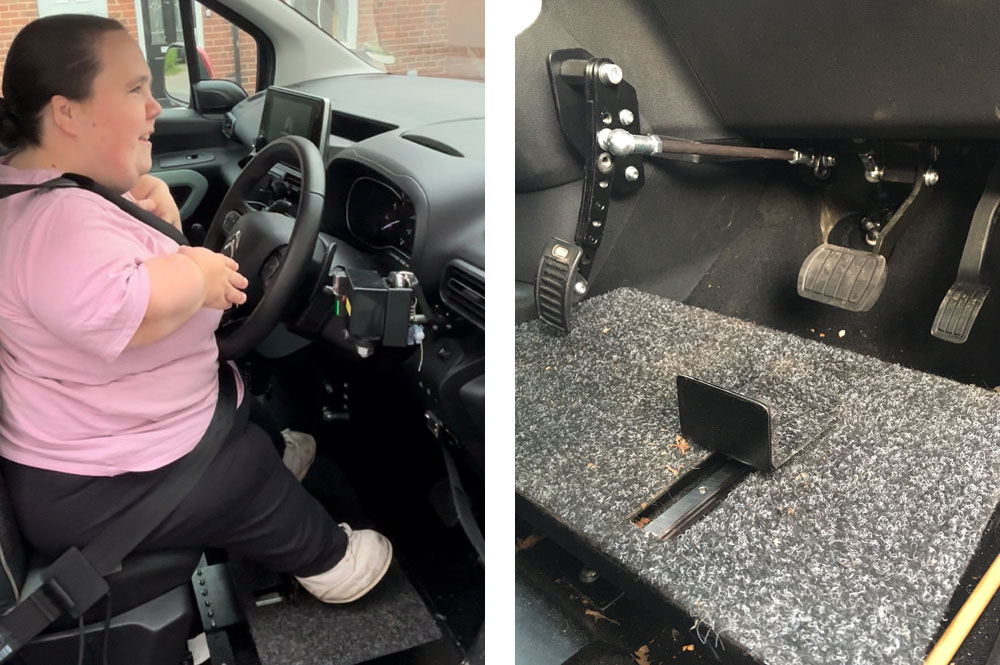
Dwarfism is a medical or genetic condition characterised by short stature, typically resulting in an adult height of 4 feet 10 inches (147 cm) or shorter. There are more than 300 known causes, with achondroplasia being the most common.
Can I drive with dwarfism?
Yes. Many people with dwarfism learn to drive successfully, often with the use of specialist adaptations that make the vehicle easier and safer to operate. These adaptations are tailored to the individual and may range from simple pedal extensions to more advanced assistive controls. Common adaptations include:
- Pedal extensions to bring the pedals within safe reach
- Adjustable or extended seats for optimal visibility and posture
- Hand controls for braking and acceleration
- Extended indicator or wiper stalks
- Electronic or extended parking brakes
A vehicle with automatic transmission may also be a suitable option, reducing the need for frequent gear changes and simplifying driving.
Getting started
The first step is to apply for a provisional driving licence, noting your medical condition on the application form. You may be asked to provide supporting medical evidence from your doctor confirming your condition and ability to drive.
Once you have your provisional licence, you can contact Driving Mobility to arrange an assessment at your nearest mobility centre. These assessments are carried out by clinicians, such as occupational therapists, in partnership with Approved Driving Instructors. Together, they will evaluate your needs and recommend suitable vehicle adaptations, as well as appropriate car models and seating arrangements.
If you receive Disability Living Allowance (DLA) or Personal Independence Payment (PIP), you may be eligible for support through the Motability Scheme, which enables you to lease a car that can be adapted to your requirements.
Learning to drive
Depending on your adaptations, you may be able to learn with a local instructor or through a specialist instructor experienced in teaching drivers with disabilities. Some instructors may require minor adjustments to their teaching approach to accommodate your driving style.
Driving Mobility can provide advice on locating suitable instructors and learning in adapted vehicles where needed.
Using hoists and scooter loading equipment
For some drivers and passengers with dwarfism, using a mobility scooter, powerchair, or wheelchair may be part of everyday life. In these cases, a vehicle hoist or loading system can make transferring and storing mobility equipment easier, safer, and more independent. Hoists can be fitted to many vehicles and are designed to lift and stow equipment into the boot or onto a storage platform with minimal physical effort.
During a Driving Mobility assessment, clinicians can provide advice on suitable hoist options and help ensure the chosen vehicle and adaptations meet your specific needs.
Financial support
If you receive certain benefits, such as the enhanced mobility component of Personal Independence Payment (PIP) or the higher rate mobility component of Disability Living Allowance (DLA), you may be entitled to financial assistance, including:
- The Driving Assessment Grant (DAG) funded by the Motability Foundation
- A 50% reduction in vehicle tax (for those on the standard rate mobility component)
- Full exemption from vehicle tax (for those on the enhanced rate mobility component)
To apply, you will need to provide documentation such as your PIP award letter, your vehicle log book (V5C), and a completed vehicle tax form (V10).
Individuals who need help funding a driving assessment may be eligible for the Driving Assessment Grant (DAG) funded by the Motability Foundation. This grant can help cover the cost of an assessment at one of our independent accredited mobility centres, ensuring that financial circumstances do not prevent someone from exploring their driving potential. For more information about eligibility and how to apply, please contact your nearest Driving Mobility centre.
Support from Driving Mobility
Driving Mobility exists to help people of all ages and abilities access safe, independent mobility. Our network of independent mobility centres offers professional assessments, practical advice, and information about vehicle adaptations, funding routes, and learning to drive.
To discuss your options or arrange an assessment, please contact your nearest centre using our Find a Centre tool.
Useful Links
